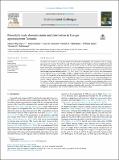| dc.description.abstract | This study was conducted to highlight status and distribution of potentially toxic elements (PTEs) in Usangu
agroecosystem-Tanzania. The study involved 198 soil samples from 10 irrigation schemes including three land
use. The concentrations of selected PTEs (Cd, Cr, Cu, Pb, Zn, As, Hg, Co, Nie etc.) were determined to estimate
status, distribution, and contamination hierarchy. The total and bioavailable PTEs were determined by aqua regia
digestion and Mehlich 3 methods, respectively. We observed variable total PTEs concentration (in mg/kg) among
land use and irrigation schemes such as Cr (15), Co (2.9), Fe (7371), Mn (263), and Zn (18.2). Also, concentration
of other PTEs (in μg/kg) were As (1382), Cd (22), Cu (3342), Hg (3.3), Ni (4107), and Pb (5661). It was observed
that 99.5, 87, 66 and 12% of the studied soils had total Fe, As, Se and Hg concentration above allowable threshold
in agricultural soils, respectively. The bioavailable PTEs fraction were lower than total values from different land
use and irrigation schemes, higher values of bioavailable PTEs were associated with agricultural intensifications.
The status of PTEs in Usangu agroecosystem observed to be at level potentially to cause damaging effect to soil
invertebrates, plants, animals and human if remain unregulated. This study highlights baseline information and
evidence for site-specific environmental management planning and a scientific basis required to establish PTEs
management in agricultural soils to ensure health food and environmental safety. | en_US |

